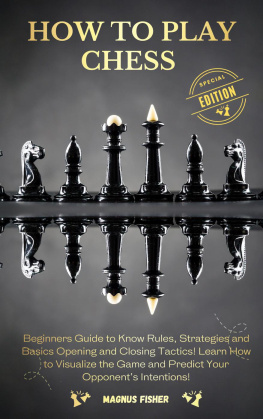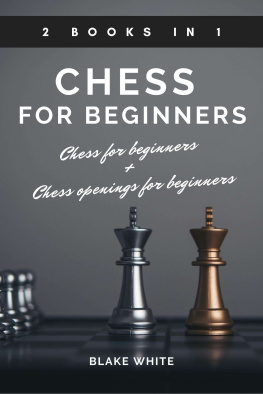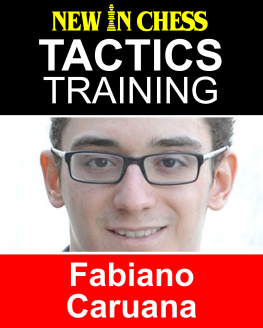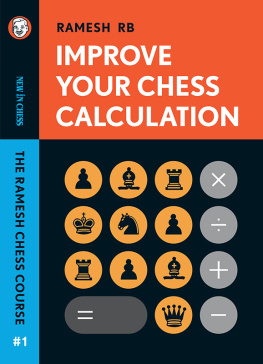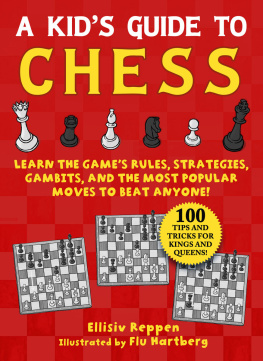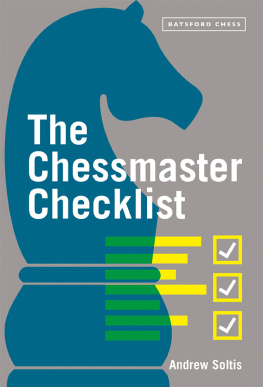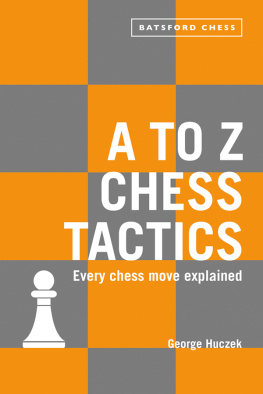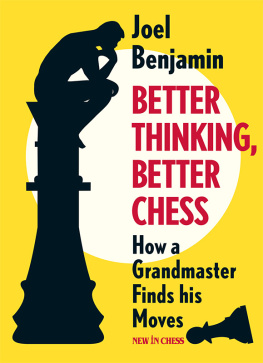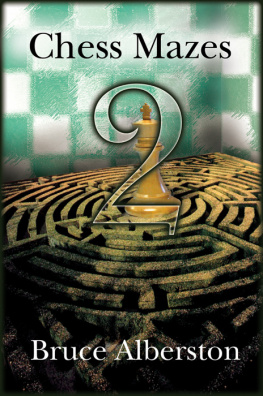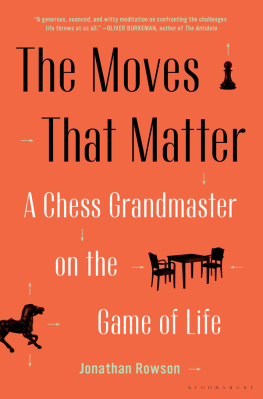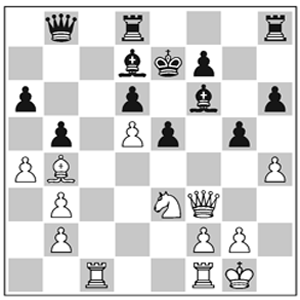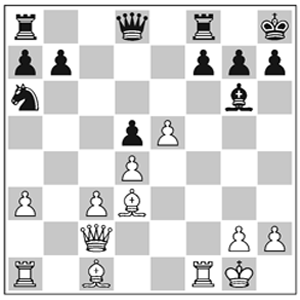Acknowledgements
Some of the material in this book has been published, in more or less identical form, in the (now defunct) Dutch chess magazine Schaaknieuws (in 2008).
The first chapter has been published in The Chess Instructor 2009 and can be read as a preview of what this book is about.
There are many positions and fragments in this book that come from my own games and my students games. Some of the others I picked up by following chess news, as well as studying the classics. And quite a lot I selected from other books: where possible, I have tried to mention the original source.
The daily Chess Today e-mail magazine deserves a special mention. Some of the more recent tactical exercises in this book I took from its daily puzzles.
So the great majority of puzzle positions are new, but a few you might al ready be familiar with.
For their help with this book, I would especially like to thank Jan van de Mortel, Peter Ypma and Anja de Wijs.
Bibliography
Books
Aagaard, J.: Excelling at Positional Chess, Everyman Chess (2003).
Aagaard, J.: Excelling at Chess Calculation: Capitalising on Tactical Chances, Everyman Chess (2004).
Avni, A.: Practical Chess Psychology, Batsford (2001).
Avni, A.: The Grandmasters Mind: A look inside the chess thinking-process, Gambit (2004).
Bareev, E. and Levitov, I.: From London to Elista, New In Chess (2007).
Bosch, J.: The Chess Combat Simulator, New In Chess (2006).
Bosch, J. and Giddins, S. (ed.): The Chess Instructor 2009: The New In Chess Compendium for Chess Teachers, Coaches and Parents, New In Chess (2008).
Bronstein, D.: Zurich International Chess Tournament 1953, Dover Publications (1979).
Damasio, A.: Descartes Error: Emotion, Reason and the Human Brain, Putnam (1994).
De Groot, A.: Thought and Choice in Chess, Mouton and Co (1965) (Translation of Het denken van den schaker (1946)).
De Groot, A. and Gobet, F.: Perception and Memory in Chess: Studies in the Heuristics of the Professional Eye, Van Gorcum (1996).
Dekkers, M.: Delarf, Contact (2002).
Dennett, D.: Consciousness Explained, Penguin (1991).
Dennett, D.: Freedom evolves, Penguin (2003).
Dennett, D.: Darwins Dangerous Idea: Evolution and the Meanings of Life, Penguin (1995).
Dijksterhuis, A.: Het slimme onbewuste: Denken met gevoel, Bert Bakker (2008).
Donner, J.: The King: Chess Pieces, New In Chess (2006).
Dunnington, A.: Can you be a positional chess genius?, Everyman Chess (2002).
Dvoretsky, M.: Secrets of Chess Tactics, Batsford (1992).
Foer, J.: Moonwalking with Einstein: The Art and Science of Remembering Everything, Penguin (2011).
Foucault, M.: Les Mots et les Choses, Editions Gallimard (1966).
Franco, Z.: Chess Self-Improvement: Assess and Improve Your Chess Strength, Gambit (2005).
Gaprindashvili, P.: Imagination in Chess: How to Think Creatively and Avoid Foolish Mistakes, Batsford (2004).
Gladwell, M.: Blink: The Power of Thinking with out Thinking, Penguin (2005).
Gobet, F., De Voogt, A. and Retschitzki, J.: Moves in Mind: The Psychology of Board Games, Psychology Press (2004).
Goldberg, E.: The New Executive Brain: Frontal Lobes in a Complex World, Oxford University Press (2009).
Grooten, H.: Chess Strategy for Club Players: The Road to Positional Advantage, New In Chess (2009).
Hansen, C.: Improve Your Positional Chess: A practical guide to making positional decisions, Gambit (2004).
Harris, J.: The nurture assumption: Why children turn out the way they do, Free Press (1998).
Hellsten, J.: Mastering Chess Strategy, Everyman Chess (2010).
Hertan, C.: Forcing Chess Moves: The Key to Better Calculation, New In Chess (2008).
Keizer, B.: Onverklaarbaar bewoond: Het wonderlijke domein van de hersenen, Balans (2010).
Kmoch, H.: Die Kunst der Bauernfhrung, Das Schach-Archiv (1956).
Kotov, A.: Think Like a Grandmaster, Batsford (1971).
Kotov, A.: Play Like a Grandmaster, Batsford (1978).
Krogius, N. (e.a.):Encyclopaedia of chess middlegames: combinations, Chess Informant (1980).
Levitt, S. and Dubner, S.: Freakonomics: A Rogue Economist Explains the Hidden Side of Everything, William Morrow/Harper Collins (2005).
Makridakis, Hogarth and Gaba: Dance with Chance: Making Luck Work for You, One World (2009).
Marovic, D.: Dynamic Pawn Play in Chess: How to use your pawns to fight for the initiative and central control, Gambit (2001).
Matanovic, A. (ed.): Chess Combinations: Anthology, Chess Informant (1995).
Mlodinow, L.: The Drunkards Walk: How Randomness Rules Our Lives, Random House (2008).
Nunn, J.: Secrets of Practical Chess, Gambit (1998).
Nunn, J.: Understanding Chess Endgames: Featuring the 100 most important endgame ideas, Gambit (2009).
Pinker, S.: The Language Instinct: How the Mind Creates Language, Harper (1994).
Pinker, S.: The blank slate: The modern denial of human nature, Viking (2002).
Pinker, S.: How the Mind Works, W.W. Norton and Company (1997).
Ree, H.: Een man merkt nooit iets, Meulenhoff (1985).
Ree, H.: The Human Comedy of Chess: A Grandmasters Chronicles, Russel Enterprises (1999).
Rowson, J.: The Seven Deadly Chess Sins, Gambit (2000).
Rowson, J.: Chess for Zebras: Thinking Differently about Black and White, Gambit (2005).
Silman, J.: The Amateurs Mind: Turning Chess Misconceptions into Chess Mastery, Siles Press (1999).
Sokolov, I.: Winning Chess Middlegames: An Essential Guide to Pawn Structures, New In Chess (2008).
Soltis, A.: The Art of Defense in Chess, David McKay Company (1975).
Soltis, A.: How to Choose a Chess Move, Batsford Chess (2005).
Soltis, A.: The wisest things ever said about chess, Batsford Chess (2008).
Suba, M.: Dynamic Chess Strategy, Pergamon Chess (1991).
Swaab, D.: Wijzijn ons brein: Van baarmoeder tot Alzheimer, Contact (2010).
Tarrasch, S.: Die moderne Schachpartie, Edition Olms (1986).
Tartakower, S.: Die hypermoderne Schachpartie, Edition Olms (1981).
Tisdall, J.: Improve Your Chess Now, Everyman Chess (1997).
Van Delft, K. and M.: Schaaktalent ontwikkelen: Een schaakcultuur creren door coachen, trainen, organisatie en communicatie, KVDC (2008).
Van Wijgerden, C. and Brunia, R.: De Stappenmethode (1987 e.v.).
Watson, J.: Secrets of Modern Chess Strategy: Advances since Nimzowitsch, Gambit (1998).
Wegner, D.: The Illusion of Conscious Will, MIT Press (2002).
Yermolinsky, A.: The Road to Chess Improvement, Gambit (1999).
Websites
ChessCaf.com, www.chesscafe.com.
Chess Today, www.chesstoday.net.
The Skeptics Dictionary, www.skepdic.com.
The Week in Chess, www.chess.co.uk.
Tim Krabbs Chess Curiosities, timkr.home.xs4all.nl/chess.
Wikipedia, the free encyclopedia, and wikipedia.org.
For news and contact information see my personal website: www.movefirstthinklater.com
Exercises for Chapter 1
1. White to move



